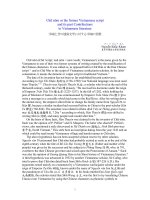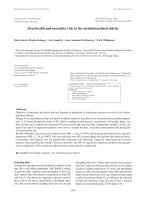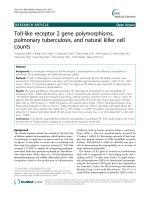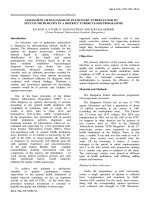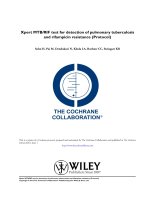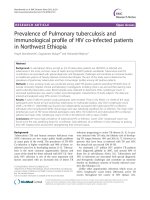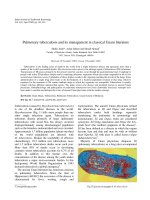PULMONARY TUBERCULOSIS AND ITS MANAGEMENT IN CLASSICAL UNANI LITERATURE pptx
Bạn đang xem bản rút gọn của tài liệu. Xem và tải ngay bản đầy đủ của tài liệu tại đây (87.56 KB, 7 trang )
Indian Journal of Traditional Knowledge
Vol. 4(2), April 2005, pp. 143-149
Pulmonary tuberculosis and its management in classical Unani literature
Shakir Jamil*, Azhar Jabeen and Shoaib Ahmad
1
Faculty of Medicine (Unani), Jamia Hamdard, New Delhi 110062
1
1437, Sector 39 B, Chandigarh 160036
Received 19 November 2003; revised 1 December 2004
Tuberculosis is the leading cause of death in the world from a single infectious disease and represents more than a
quarter of the world's preventable deaths. Mycobacterium tuberculosis is the etiologic agent of tuberculosis (TB) in humans.
Transmission of TB occurs primarily by the aerosol route but can also occur through the gastrointestinal tract. Coughing by
people with active TB produces droplet nuclei containing infectious organisms which can remain suspended in the air for
several hours. Infection occurs if inhalation of these droplets results in the organism reaching the alveoli of the lungs. Since
administration of a single drug often leads to the development of a bacterial population resistant to that drug, effective
regimens for the treatment of TB contain multiple drugs to which the organisms are susceptible. Tuberculosis is usually
treated with four different antimicrobial agents. The paper reviews the disease and treatment known to ancient Unani
physicians. Pathophysiology and pathogenesis of pulmonary tuberculosis have been elaborately discussed. Attempts have
been made to correlate and interpret the views of ancient Unani physicians with the modern concept.
Kewwords: Unani Drugs, Tuberculosis, Pulmonary Tuberculosis, Unani System of Medicine.
IPC Int. Cl.
7
: A61K35/78; A61P31/06; A61P31/10
Tuberculosis (caused by Mycobacterium tuberculosis)
is one of the deadliest diseases in the world.
Mycobacterium (Fig. 1) kills more people than any
other single infectious agent. Tuberculosis an
infectious disease primarily of lungs (pulmonary
tuberculosis) with social bias has always occurred
disproportionately among disadvantaged population
such as the homeless malnourished and over crowded.
Approximately 1.7 billion population (about one-third
of the world population) are infected with
M. tuberculosis. Despite the availability of effective
chemotherapy, 10.2 million new tuberculosis cases
and 3.5 million tuberculosis deaths occur each year.
More than 95% of deaths occur in developing
countries where tuberculosis accounts for 6.7% of all
deaths. In addition to this human cost, the
concentration of the disease among the youth makes
tuberculosis a major socio-economic burden. In this
background, World Health Organization in 1993
declared tuberculosis a global emergency
1
.
The ancient Unani literature has numerous citations
on pulmonary tuberculosis. Since the time of
Hippocrates (460 B C) the occurrence of the disease is
characterized by fever, wasting, cough and
expectoration. The ancient Unani physicians termed
the tuberculosis as Sil and Dique and described
tuberculosis under both headings separately
maintaining the uniformity in terminology and
nomenclature. Sil and Dique, terms are considered
synonyms, Sil being emaciation and Dique the low-
grade fever (the cardinal symptoms of the disease)
1
.
Sil has been defined as a disease in which the organs
become lean and thin and may be with or without
ulcer (Qarha). Sil with ulcer is called huma-e-dique
(tubercular fever)
2
.
Majority of Unani physicians diagnose Sil
(pulmonary tuberculosis) as a lung ulcer accompanied
_
_________
*
Correspondening author
Fig.1 Electron micrograph of M. tuberculosis
INDIAN J TRADITIONAL KNOWLEDGE, VOL. 4, NO. 2, APRIL 2005
144
by Dique (tubercular fever). Some physicians opine
that Sil applies for both lung ulcer (Qarha revi) as
well as Huma-e-dique (tuberculosis). Sil is an ulcer,
which may occur in lungs followed by Dique while in
others view, Dique is Huma (fever) and stays in the
body so much so that the fluids of the body get
destroyed by its heat
3
. Dique may be due to the heart
temperature, which destroys the fluids from the
organs
4
. Sil has been mentioned as exudation, exit and
becoming naked. It is called Sil, since bones become
prominent due to wasting and emaciation of muscles.
Body affected by the disease loses its muscles to a
great extent there by reducing the body to a skeleton
equated with unsheathed sword (saif-i-maslool)
5
.
Qarshi mentioned that this disease is a compound one
in which the presence of fever is must
6
. Sil is also
defined as a special type of ulcer caused by a specific
type of Madda
7
.
Sil has also been described as wasting because
emaciation is a special characteristic of this disease
and ulcer means disruption and discontinuity of
muscles and formation of pus. The symptoms of the
disease are due to ulceration of lungs. The patient
suffers from fever and expectorates pus with cough
6
.
Lungs are injured in sil
8
.
Some Unani physicians introduced the word
Aqtiqoos as another synonym of sil and have also
mentioned the fever Dique as Aqtiqoos
2-4
. Dique
means softness and leanness. It acquired its name as it
is a low-grade fever tends towards leanness. Dique
and sil are in fact two names of the same disease.
Buqrat (460 BC), the father of medicine also believed
these names as synonymous
9
. Huma-dique is unusual
and unnatural temperature which gradually damages
the organs of the body (Aaza asliya) and destroys the
fluids secreted by the body
10,11
.
Classical Unani physicians have separately
described Sil and Dique but they have practically
treated the two terms as synonyms. The physicians in
general have treated Sil as a lung ulcer which is
necessarily accompanied by Dique. Allama Qarshi
has defined Sil as a sum of the lung ulcer and Dique
(fever). Tadarun, another name for Sil or Dique also
is a synonym
5
. The term however is not found in old
Unani literature. The equivalent of this disease in
modern medicine is tuberculosis. Tuberculosis has
been derived from the word tubercle as this disease is
characterized by formation of tubercle lesions. The
Unani scholars of this era have introduced the term
Tadarun which literally means tuberculosis. So
Tadarun-e-revi means pulmonary tuberculosis.
Humma-e-dique is tubercular fever and Dique
represents tuberculosis. The Sil is tuberculosis of
lungs particularly where the disease is of ulcerative
nature. However some scholars differ and consider Sil
as synonymous to Dique which may involve any part
of the body
12,13
.
Pathophysiology:
Unani physicians define Huma-e-dique as fever in
which the abnormal heat (Hararat gariba) is initially
related to vital organs (Aaza asliya) with reference to
heart. It slowly and steadily destroys the fluids of the
body
14
. Majoosi and Ibn-e- Sina have classified this
fever (Huma Dique) into three stages so for as its
transference from one fluid to another one is
concerned
3,4
. In the first stage this abnormal heat
annihilates the fluids present at the ends of capillaries
and starts annihilating the fluids found in the fissures
of the organs and their spaces. First stage is
understood simply as Dique or Dique mutlaq
(absolute Dique). Some worker found it extremely
difficult to diagnose tuberculosis at this stage though
the treatment is possible
3
.
According to some scholars it is the second stage
when the heat (Hararat gariba) has completely
annihilated the fluid present in the fissures of the
organs and is about to affect the fluid by which the
organs are interconnected with each other
3,7
. This
stage is known as Zabool (wasting). Some scholars
describe the stage of Zabool as Farlimoos and found
the treatment at this stage very difficult
3,15
.
In the third stage when the second stage fluids have
already annihilated and third stage fluids have started
being affected by heat i.e. those fluids which are
obtained from the elements at the time of birth. This
fluid is also called Ratoobat ustaqsiya and Ratoobat
manviya. Ratoobat manviya due to which the
elements of the individual organs are interconnected
since birth. By the annihilation of this fluid the
elements of organs are turned into pieces. Ibn-e-Sina
mentioned this stage of tuberculosis as Muffatit and
Muhashif (disintegration)
4,15
.
Some ancient physicians are of the opinion that
when the temperament of heart shows a change but
the fluids are yet to be dissolved this is the first stage.
When fluids get annihilated this is the second stage.
In the third stage the heat shows its effect on the
arteries, veins, membranes and individual organs.
JAMIL et al.: PULMONARY TUBERCULOSIS TREATMENT IN CLASSICAL UNANI LITERATURE
145
According to Unani System of Medicine Soo-e-
mizaj (derangement of the temperament) mostly due
to disequilibrium in the quantity or quality of Akhlat
(fluids of the body) and disturbance in the Asbab-e-
sittah zarooriah (six essential causes for good health)
are the main etiological factors in most of the
diseases.
The Unani physicians have divided body into three
parts: Ada (organs), Akhlat (humours) and Arwah
(pneuma). These parts of the body are the seats for the
diseases. Fever is an abnormal temperature (Hararat-
e-gair tabai) which effects and is seated in any of the
three parts namely Ada, Akhlat and Arwah. According
to Ibne-Sina this abnormal heat (Hararat gariba)
strikes Aaza (organs) and gets seated into the organs;
it produces a kind of fever called as Huma-i-dique
(tubercular fever)
4,15
.
Causes of Dique have been described as:
1. Asbab sabiqa (preceeding causes).
2. Asbab badiya (extrinsic causes).
Regarding the etiology of Huma-e-dique Dique is
caused due to asbab sabiqa like Huma-e-uffonat
(infections), Huma-e-murakaba (compound fever),
warm sadar, chronic fever and Huma-e-youm
2
.
Chronic fevers are responsible for the destruction of
the body fluids, leading to Dique. Asbab sabiqa and
Asbab bidiya like anxiety, frightening, awaking,
malnutrition, and rage are mentioned as hot and dry
temperament
3
. Huma-dique does not occur directly in
the body it follows Huma-youm or it occurs to those
people who are susceptible or who indulge in
strenuous work or those people who take very low
diet or plenty of hot and dry medicines
12
. Some of the
scholars are of the opinion that Dique fever occurs
after attack of some other fever in the body
13
.
Four disorders in the body have been described,
which can lead to Dique, if not managed properly:
1. Sue-e-mizaj maddi (derangement of temperament
with morbid material).
2. Diseases of the kidney.
3. Urinary bladder ulcers.
4. Ziabetes (Diabetes mellitus).
Sil rewi (Pulmonary tuberculosis):
Different authorities of Unani medicine have
described the causative factors for Sil rewi as:
• Insibab-e-nazla (descending of catarrhal
discharge) which is irritant and corrosive and
causes infection descends from head and falls
upon lungs
4,6,16
.
• Similar type of acute and corrosive substance,
which falls upon the lungs from any organ other
than brain
4
.
• Pneumonia when not resolved causes ulcer
4,6
.
• Zatul janb (pleuritis) or Zatus sadar, when not
resolved, rupture of the lung vessels
4,15
.
• Auto infection (primary infection) and corrosion
of lung mass
4,15
.
Some scholars like Ibne Sina believed that lean,
weak, pigeon-chested persons with excessive bile and
the persons between 18 and 30 years of age are
susceptible. There is an increased incidence of the
disease at cold places and in those persons who
generally suffer from cold (Nazla) and their mouth
have starfish smell
4,15
. Sil is an infectious disease and
it communicates from one person to another
4,7,12-14
.
This disease is transmitted even if a person sits near
the patient and if one inhales the breath of the patient.
It is clearly understood while going through the
above discussion that alteration in the quantity or
quality of Akhlat is the basic concept of the disease
and disturbance in the Asbab-e-sitta daruriya
alongwith alteration of Akhlat is the main etiology of
the diseases in Unani medicine. The Asbab-e-sitta
daruriya consist of external and internal factors. The
first two of the Asbab-e-Sitta daruriya are
atmospheric air, food and drinks. Unani physicians
have also divided the causes of Sil and Dique into
Sabiqa and Badiya. Sabiqa causes are Huma (fevers)
like Huma-e-uffunat (infections), Huma-e-murakkaba
(compound fever), chronic fever, Huma-e-youm (day
fever), pneumonia, pleuritis, autoinfections. Badiya
are extrinsic causes like anxiety, malnutrition, and hot
and dry temperament. They have also given emphasis
on predisposing factors like diabetes, malnutrition,
any chronic disease and environmental factors like
congested areas crowded places and lack of fresh air.
It has also been believed that whenever change occurs
either in air or in water and get contaminated they
cause Uffonat of akhlaat (sepsis of humors) and thus
causing the disease.
Some physicians not only described the
putrification of water and air but also named the
substances which cause putrification as Ajsame
Ardiyah Khbitha (Microorganisms, becoming the first
one to give idea regarding the existence of these
organisms, which pollute water and air. These
substances after invasion cause infection (Tadiya)
4,15
.
INDIAN J TRADITIONAL KNOWLEDGE, VOL. 4, NO. 2, APRIL 2005
146
Similarly Unani physicians have also described the
Tadiya and Waba (epidemic) in their texts
17
. Sil has
been considered as an infectious and communicable
disease
4,15,18
. Earlier Unani physicians had a concept
about the infectious nature of the disease, Sil and the
causing agent Ajsame Khabitha (microorganisms).
Symptoms and signs
Pulse is subtle, firm, continuous and weak. Fever is
continuous till morning. Fever is constant and due to
the gradual change in temperament (Sue-mizaj
mustavi) the patient does not feel the intensity of
fever. Temperature rises after meals and pulse tends
to be stronger. The fever does not subside even after
three or more days and is of low grade and does not
have the symptoms of infectious fever like chills,
rigors, thirst, irritability, dryness of tongue and foul
smelling urine.
The patient becomes lean and thin. Body skin is dry
and thin. Face turns pale and eyes sink. The facial
bones become prominent and bones and skin come in
contact due to wasting. Both temporal sink.
Clinical features include:
Purulent expectoration.
Blooded sputum with cough.
Huma-dique (tubercular fever).
Sputum contains dry fibrous tissue, emaciation of
the body, night sweating, nails become curved and
hair starts falling, ribs start protruding out leading to
loss of appetite. In autumn season the pulmonary
tuberculosis patient's condition becomes more
conspicuous and diagnosis becomes easier.
Management of Pulmonary Tuberculosis
The general constitutional treatments that have
been advocated through centuries by Unani
physicians were targeted to improve the resistance of
the patient to combat successfully the disease
pathology.
Unani physicians of earlier centuries mentioned
that, it could be controlled in the initial stage
3
. When
purulent expectoration is due to Sil its treatment is
very difficult due to the following reasons:
1. Timid and spongy lungs and thin blood vessels
leads to longer healing time for ulcers.
2. The drugs loose their potency as they cover a long
distance to reach lungs.
3. The ulcerated part of the lung which in fact needs
rest to heal up also keeps on moving.
4. The network of blood vessels inside the lungs is
comparatively wider and it takes a longer period
to heal up.
It is also recorded that the childhood Sil generally
responds better to the treatment as compared to
adulthood Sil.
Following principles are followed while treating a
Sil patient:
1. Tajfeef qarha (desiccation of ulcer)
2. Iltiham (healing of ulcer)
3. Tanfeeth wa tagriya (expectoration and
lubrication)
4. Tanqiya (cleansing of wound)
5. Strengthening of stomach
6. Stabilization of temperature
7. Diet
Sil is always accompanied by tubercular fever and
considering the nature of Dique. Care is taken to give
plenty of fluids keep body cool compensate
deficiencies and strengthen the vital body organs.
Desiccation of ulcer may be needed along with
providing fluids because the treatment of ulcer is
based on its desiccation.
While treating a Sil patient, medicines which help
in desiccation are administrated. They prove an
impediment to the expectoration of sputum etc.
thereby aggravating the symptoms of Dique. However
in order to overcome this problem expectorant drugs
are given the ulcerous part remains moist and does not
heal. The other problem is that drugs given to keep
the body cool do not reach the required spot.
Similarly by administering hot temperamental drugs
the body temperature is increased. It necessitates that
all such drugs be given in a compound form.
Liquors are administrated to provide warmth and
energy to the body. Cold temperamental drugs have
been recommended to be used along with hot
temperamental drugs e g Gurse kafoor with Gulqand
5
.
When attention is paid to cure the ulcer hot and dry
temperamental drugs are administrated thereby
causing the aggravation of fever, dryness and
emaciation. However when attention is paid to control
fever the ulcer does not heal up due to moisture
provided by the drugs.
To overcome the difficulty the physicians at the
first instance attempt to control fever.
Tabashir
(Bambusa arundincea) Gul surukh (rosa Damascus),
Tukhm khayar (Cucumber seeds) Gil armani and
JAMIL et al.: PULMONARY TUBERCULOSIS TREATMENT IN CLASSICAL UNANI LITERATURE
147
Kehruba (Ambreskenum) are used in the form of
along with dilute curd. Following drugs namely
Kundur (Boswellia serrata), Raywand (Rheum
emodi), Gil makhtoom, Koukabul arz (talc), Barsami,
Nishasta (starch), Kateera (Sterculia urenus), samag
arbi (gum Arabica), khashkhash abyad (white opium
seeds), Afyoon (opium) are also to be taken. Later,
Persiawshan (Adiantum capillus-veresus) has been
added as an anti-inflammatory and cleanser
19
.
Following management for pulmonary tuberculosis
(Sil) has also been suggested
12
:
• Donkey’s milk, goat’s milk and protein rich diet
like meat of birds.
• Hammame Moatadil and Aabzan (Sitz bath).
• Powder of following medicines: Tabasheer,
Acacia arabica gum (Samagh-e-Arbi), Armeniam
Bole (Habbul Aas), Persiawshan, kundur, Punica
granatum (Gulnar).
In the context of Dique some physician has even
mentioned the mamagement of Humma-e-Dique with
its different stages
12,13
.
First Stage: If the symptoms of Dique are mild
(fever, weakness and dryness of the body are mild)
then it is first stage of Humma-e-Dique. The patient
should be given barley water (Aashe Jao), fish kebab
and other vegetables like Khurfa (Portulaca
oleracea), Kanocha, Kadu (Cucurbita moschata), etc.
Second Stage: If Humma-e-Dique progresses inti
second stage (Sanvi darja) and moderate weakness is
present then the above mentioned management should
include Aashe Jao, Hammam along with donkey’s
milk, goat’s milk, Qurs-Tabasheer, Maaul leham
(meat water), etc.
Third Stage: If Humma-e-Dique progresses into
third stage the patient is emaciated and is extremely
weak then easily digestible food should be given e g
soup of bird meat, chicken soup, etc. However in this
stage recovery is very difficult.
Following management for tuberculosis has also
been mentioned:
• Crabs boiled with Maul Shair (Barley water,
Hordeum vulgare).
• Egg yolk, chicken, almond oil.
• Sitz bath followed by massage with Roghan
Banafsha (oil of sweet violet, Viola odorata).
Some physicians have advised for mucolytic and
desiccant drugs for ulcers and suggested the use of
diuretics to keep the ulcer dry. Most of the Unani
physicians advised for drinking milk preferably
donkey's milk as it supposedly cleans the ulcer
rehydrates body and increases the body resistance to
combat the disease. Most of the Unani physicians
mentioned human milk to be most useful in Sil
followed by milk of donkey and goat
2-4,12,13,15,20
.
Some Unani physicians
7
have even mentioned the
following medicines and prescriptions for the
treatment of tuberculosis:
Cough with haemoptysis:
Formulation: Geru (Bole rubra), Sang Jarahat
(Soap stone), Dammul Akhwain or Dragon’s blood
(Dracaena cinnebari), Nakhud Sokhta or roasted
gram (Cicer arietinum), Rubbus Soos or extract of
liquorice (Glycyrrhiza glabra), Samagi Arabi. Kateera
I gm each. Fine powder of these drugs is mixed with
20 gm of Khameera Khashkhash and the mixture is
divided into two parts; one part is to be taken in the
morning and the other one in the evening. After that
decoction of Behidana or Quince seeds (Cydonia
oblonga) (3 gm), Unnab (Zizyphus vulgaris) (5 Nos.),
and Sapistan (9 Nos.) mixed with Sharbat Banafsha
(20 ml). Alternatively the following prescription may
be used: Roasted crab (150 gm), Rubbus Soos, Gond
Babool (Acacia senegal), Kateera, Banslochan or
bamboo manna (Bambusa arundinaceana), Dana
Ilaichi Khurd (Elettaria cardamomum), Saresham
Mahi, Sat gilo, (Extract of Tinospora cordifolia),
Kahrubai Shamai or Ambar (Pinus Succinifera) 500
gm each. Fine powder of these drugs is mixed with 20
ml of Sharbat Khashkhash.
Nuksa Gariu-samak: Saresham (2 gm), and Misri
(20 gm) and is taken after boiling in 100 ml milk.
Dabai-Kibreet: Gandhak Amla Saar (sulphur)
(1 gm) finely powdered and is taken with Sharbat
Aijaz (10 ml) or Khameera Khashkhash (10 ml) or
Laooq Sapistan (20 mg).
Dawai-Khurfa-Naushadar (Profuse haemoptysis):
Tukhm-khurfa (2 gm) and Naushadar (Sal ammoniac)
(6 gm) are taken in an earthen pot its mouth is closed
by Fuller’s earth and put on the flame/heat of Pachak
Dashti for one hour; 450 gm out of it is taken after
mixing with Sharbat Anjibar. If it causes se motions
then Qurs Tabasheer Kafoori (5 gm) is given with
Sharbat Habbul Aas (20 ml) or Sharbat Khashkhash
(20 ml).
Effective/useful compound formulations
Sharbat Faryadras, Sharbat Aijaz, Qurs Sartan
Sadah anf Kafoori, Qurs Kafoor, Dayaquzah,
Gulqand, etc.
Tabreed (Cooling) and Tarteeb (Wettting)
INDIAN J TRADITIONAL KNOWLEDGE, VOL. 4, NO. 2, APRIL 2005
148
Following has been recommended in the treatment
of Dique:
Sitz bath in lukewarm water or other liquids
followed by application of Roghan Banafsa (oil of
sweet violet, Viola odorata). Cold and moist
vegetables like Khurfa, Khubbazi or Common mallow
(Malva sylvestris), Kahu (lettuce) leaves (Lactuca
sativa), Kaddu, Kheera or cucumber (Cucumis
sativus), fish and chicken meat. Application of cold
Tila on chest like sandal, Gulab, Khurfa, Aab Dhania
Sabz or water of green coriander (Coriandrum
sativum).
Mamoolate-Matab (Clinical prescriptions)
For nutrition of the body Dawai-Dique is given
along with goat milk in the morning. (Ingredients of
Dawai-Dique: Baladur Mudabbar or Marking nut
(Semecarpus anacardium), Sat Gilo, Tabasheer,
Ilaichi Khurd and Filfil Siyah or Black pepper (Piper
nigrum) (1 gm each, finely powdered).
(a) In the evening 1 Qurs Tabasheer is given
followed by Gilo Sabz, Aslussoos, Tukhm Khayyarain
(3 gm each) in Arq Hara Bhara (60 ml) and Arq
Sheer (60 ml) mixed with Sharbat Neelofar (20 ml).
Donkey milk, goat milk, Kaddu water or watermelon
(Citrus vulgaris) (70 ml) is given for first three days,
increasing 10 ml each day till it reaches 210 ml,
thereafter 10 ml is decreased each day till it reaches
again to 70 ml.
(b) Dawai-Dique is given along with donkey milk
or goat milk in the same way. If too much weakness is
present compounds of iron, gold or copper is given.
Loab-Behidana or Quince seeds (Cydonia oblonga)
(3 Nos.), Sheera Maghz Kadu (3 Nos.), Sheera Magz
Tukhm Tarbooz or watermelon seeds (Citrus vulgaris)
(3 Nos.), Sheera Tukhm Khurfa Khurfa or Purslane
seeds (Portulaca oleracea) (3 Nos.) are given along
with Sharbat Neelofar (20 ml).
Qurs Tabasheer and Qurs Kafoor (Pharmacopoeal
preparations) may also be given.
Honey and honey water have been recommended to
clean the lung ulcers purulent expectoration and for
tuberculosis
2,12,14
.
Dry air is also useful in healing of ulcers. Patients
are advised to live in dry places.
Venesection of head and face is recommended for
physically strong patients
4,20
. After vensection
purgative of Amaltas (Cassia fistula) with Turangbeen
(Manna) is recommended. Decoction of unab,
sapistan (Cordia latifolia), maveez (Vitis vinefera)
and banafsha may be administered thereafter. Strong
purgatives like turbud (Operculina turpethum),
gariqoon (Polyorous officinalis) should never be
administered. Some has even recommended cupping
in case venesection is contraindicated.
Rose oil and khari oil massage on chest are
recommended
2
. Pumkin oil, opium oil, neelofer
(Nymphaea lotus) oil, banafsha oil for body massage
followed by bath
4,12,13
along with goat milk in case the
body is dry and lean.
Turkish Bath
Razi advises bath with lukewarm water before and
after meals. Ibn sena recommends it before meals.
Majoosi has advised for oil massage after the bath.
Diet
Razi advises fish, bird’s flesh, barley water and
rose water. Majoosi also recommends chicken and
teehu meat, moong pulse in the form of asfaidbaj (a
form of soup prepared from chicken or other soft meat
and vegetables, cereals, etc.). Ibn-e-Sina favors fat
free soft meat, fish and pulses (avoid the fish in
malignancy). Azam stresses the use of sarisham mahi
(Isinglass).
Treatment
Hyperthermia
Ibn-e-Sina recoomends hot temperamental seeds
like Tukhm anisoon (Pimpinella anisum seeds), rRb-
u-soos, persiawshan in the form of syrup. He has also
suggested barley husk cooked with crab for pyrexia.
Razi advises Qurs-e-tabasheer and Qurse kafoor and
massage of sandal, camphor and rose water on chest.
Cough
Majoosi recommends cough suppressants as cough
proves an impediment to the healing of the ulcer.
White opium seeds, gum, starch, Kateera, Tabasheer
(Bambusa arundinacea), Rabu-soos is useful for both
ulcer and cough. This is to be followed by drinking
opium syrup or grape syrup. Ibn-Zaheer recommends
Aslasoos. Majoosi advises chewable tablets made
from Magz tukhm kaddu (guard seeds), cucumber
seeds, melon seeds, behdana, opium seeds, Tukhm
khurfa, gum, Kateera, Tabasheer and sugar. Jurjani
recommends Kahu (Lactuca sativa) seeds after being
cooked in barley water. He also recommends Sharbat
zoofa (Hyssopus officinalis) as expectorant.
JAMIL et al.: PULMONARY TUBERCULOSIS TREATMENT IN CLASSICAL UNANI LITERATURE
149
Haemoptysis
Tabri advises curd milk from which cream is
removed and hot iron pieces are added to it and
cooked. Razi and Jurjani recommend gil makhtoom
(Bolus makhtoom), nishasta (starch), gul surskh,
kehruba (Ambreskenum), habul aas, grinded crab,
tukhm banafsha, kateera, tabasheer, gum, asalasoos,
in the form of tablets.
Apart from mucolytic desiccants and healing agents
Unani physicians have given stress on usage of crab,
milk, fish, barley and honey, etc. Crab and barley
water are considered very effective in tuberculosis
and most of the physicians have mentioned its usage
in tuberculosis. Unani physicians have emphasized on
the improvement of the resistance of the patient to
combat successfully the disease. For this reason they
have given more stress on nutritious diet especially
protein rich diet.
Acknowledgement
Authors are thankful to Panacea Biotech Ltd., New
Delhi for providing a fellowship to one of the authors
(AJ) for “A Study on Management of tuberculosis
with a Herbal Unani Product (Lawsonia inermis) as
an Adjuvant Drug” and also to Jamia Hamdard, New
Delhi for providing the clinical facilities for carrying
out the studies at its Majeedia Hospital, New Delhi.
References
1 Jabeen A, A Study on Management of Tuberculosis with a
Herbal Unani Product (Lawsonia inerrmis) as an Adjuvant
Drug, M D (Moalijat) Thesis, Jamia Hamdard (Hamdard
University), New Delhi, 2003.
2 Tabri R, Firdous ul Hikmat, (Hamdard Foundation, Karachi),
1981, 755-762.
3 Majoosi I A, Kamilus Sana, Vol. II, (Munshi Naval Kishore,
Lucknow), 1889, 217.
4 Ibne Sina, Al Qanoon, Vol IV, (Munshi Naval Kishore,
Lucknow), 1929, 79-86.
5 Kabiruddin, Al Qanoon, Vol I & II, (Tibbi Company,
Rawalpindi), 1940, 506-524, 1593-1609.
6 Arzani M A, Tibbe Akbar, Vol I, (Munshi Naval Kishore,
Lucknow), 1903, 243-247.
7 Kabiruddin, Sharah Asbab, Vol II & IV, (Hikmat Book
Depot, Hyderabad), 1916, 470-475, 525-532.
8 Jurjani M I, ZakheeraKhuwazzum Shahi Vol II, (Munshi
Naval Kishore, Lucknow), 1878, 288-297.
9 Ajmali M M, Bukharon ka ilaj, (Daftar Maseehul Mulk,
Delhi), 1950, 325-333.
10 Khan M A, Akseer Azam, Vol. II, (Munshi Naval Kishore,
Lucknow), 1984, 206-233.
11 Karim N M, Shaful Auraz wa Muazunul Ilaj, (Munshi Naval
Kishore, Lucknow), 640-646.
12 Razi Z, Kitab Al-Mansoori, (Central Council for Research in
Unani Medicine, New Delhi), 1991, 354-355, 404-408.
13 Razi Z, Kitab Al-Havi, Vol. IV, (Central Council for
Research in Unani Medicine, New Delhi), 65-103.
14 Kabeeruddin, Adviya ki do Taqseem, (Almaseen,
Hyderabad), 40-42, 64-65.
15 IbneSina, Al Qanoon, (Munshi Naval Kishore, Lucknow),
1931, 100.
16 Qutubuddin, Al-Aqsarai, (Munshi Naval Kishore, Lucknow),
67-71.
17 Azmi A H, Basic concepts of Unani Medicine (Jamia
Hamdard, New Delhi), 1995, 102-109.
18 Jamil S & Khan A J, Concept of Infection in Unani
Medicine, Stud Hist Med, 18(1-2), (1984), 61-65.
19 Ibn-e Zaher, Kitabul Taiseer, (Central Council for Research
in Unani Medicine, New Delhi), 1986, 100-104.
20 Tabri M, Moalijat Buqratia, Vol. II, (Central Council for
Research in Unani Medicine, New Delhi), 1995, 100-104.
